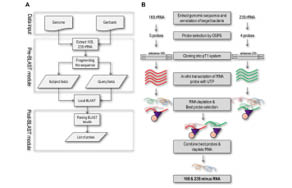Lentiviruses are robust tools for cell line engineering and development. As opposed to models that only infect dividing cells, lentiviral vectors are ideal for long term gene delivery into dividing and quiescent cells. This post is aimed at introducing the newest evolutions of lentiviral experimental approaches: the 3rd generation lentiviral plasmids.
Over the last decade, Lentivirus progressively became a research tool for stable cell line engineering and production. What makes them so attractive?
Lentiviral particles for cell line development
After retro-transcription of their RNA genome, lentiviruses randomly and stably integrate into the DNA of the host cell.
These particles are able to infect most mammalian cells (mouse, rat, human…), making them a first choice for in vitro transduction.
Depending on the cell type, lentiviral transduction efficiency is classically higher than 40%. Their relatively easy production capacities have been an asset for hard-to-transfect cells, genome integration of large inserts and the need for efficient and stable transgenesis.
Lentivirus plasmids
Lentiviral plasmids can accommodate inserts up to 8 kb in size. It is important to notice that transduction efficiency decreases for inserts bigger than 6 kb; large inserts being correlated to increasing the percentage of empty non-infective lentiviral particles.
There are several types of lentiviruses: HIV, FIV, SIV, EIAV and Visna.
The most used for gene delivery applications are HIV and FIV. Both have been modified to be safe, replication defective and with a capacity for large inserts.
3 plasmid elements are required to produce lentiviral particles:
- a lentiviral vector with the insert (miRNAs, ORFs, shRNAs, sgRNAs…)
- a packaging vector or a set of packaging vectors
- an envelope vector
In the normal lentiviral genome, all necessary components for packaging and replication are found contiguous and flanked by LTR sequences.
The 2nd generation packaging systems provide the machinery for virus construction from one single plasmid (env, gag, rev, pol and TAT). This plasmid needs to be co-transfected in the host cell along with a vector carrying the desired insert and flanking LTR sequences.
The new Lentiviral plasmid generation
For safety purposes, a 3rd generation lentiviral packaging system have been designed. This new lentiviral generation provides the same elements as the ones described above but redistributed on two independent plasmids:
- one vector with enveloppe proteins
- a second vector with the packaging /r eplication proteins: gag, pol and rev)
This 3rd generation system does not use the HIV protein tat. This optimisation allows the production of full length virus from the transfer vector. In addition, a large deletion in 3’LTR and an extensive mutation of the 5′ LTR sequences have been integrated to make viral progeny defective for self replication.
Looking for the 3rd Lentivirus generation?
With the new generation of lentiviral plasmids, efficiency, handling and versatility of lentivirus have never been so high.
These recent developments are suitable for researchers seeking to produce stable cell lines from hard-to-transfect or quiescent cell cultures. Easily available, these new Lentiviral plasmids also allow the transfection of large proteins.
And you, how do you develop your in vitro cell lines?


